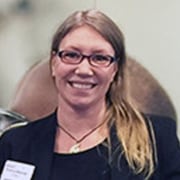To facilitate the understanding of his research, Mark provided an explanation of Epigenetics to the audience (a mix of scientists and non-scientists) in what I thought was an elegant analogy to introduce such a complex concept. The example was of the caterpillar that encloses itself in a cocoon and through metamorphosis emerges as a butterfly. The caterpillar and butterfly are genetically identical, but drastically different looking. Epigenetics can be explained as the mechanisms that dictate different genes being expressed at different times in the life of the caterpillar.
So how does epigenetics factor into regulation in normal and malignant hematopoiesis? It has been known for a while that cell fate is not a one-way path and Mark recounted a moment many years ago at a pub in the UK where he was sharing a drink with Sir John B. Gurdon (who jointly was awarded The Nobel Prize in Physiology or Medicine 2012, together with Shinya Yamanaka for the discovery that mature cells can be reprogrammed to become pluripotent).
Mark asked Sir John why he did the nuclear transfer experiment that led to his Nobel award many years later. Sir John responded that he wanted to challenge the dogma that cells are irreversibly committed to their fate. He was referring to the experiment where Gurdon removed the immature cell nucleus in an egg cell of a frog, and took the nucleus from a mature frog intestinal cell, and placed it into the nucleus-free egg. The experiment ultimately resulted in living tadpoles!
The results of these experiments showed that DNA of a mature cell still have all the information needed to develop all cells in the frog, and that cell fate is reversible. This early discovery of cell fate is highly relevant for blood cancers, especially Acute Myeloid Leukemia (AML) which genetically is a simple disease (one translocation on a chromosome causes the disease). However, identifying which patient will suffer a recurrence of the disease is dependent on assessing the epigenetic regulators.
Professor Mark’s research showed that AML could return to patients if they had a mutation on one of the Epigenetic protein regulators. This discovery led to Mark being able to target the epigenome with drugs that block defective proteins, and thus investigate therapeutic resistance in AML. However, three years ago they discovered that BET inhibitor (anti-cancer) drug resistance develops in the stem cells. This evolution from being sensitive to resistance showed no evidence of any mutation, instead, different pathways were triggered. To visualize these different protein pathways and how drugs blocked them, Mark cleverly employed a street map to show how the normal fastest routes are blocked by regular drugs and how epigenetic techniques “understand” the cells and predict the next route and subsequently block proteins there.
